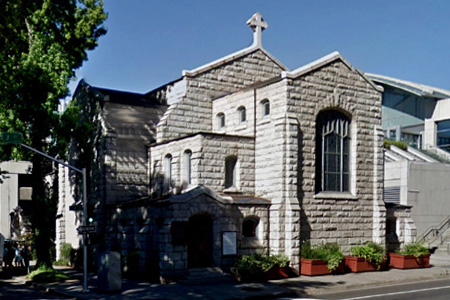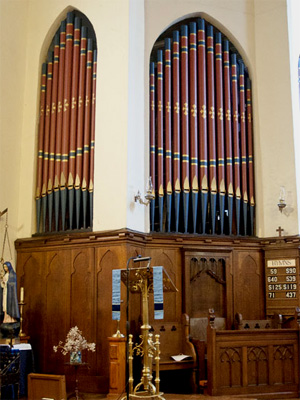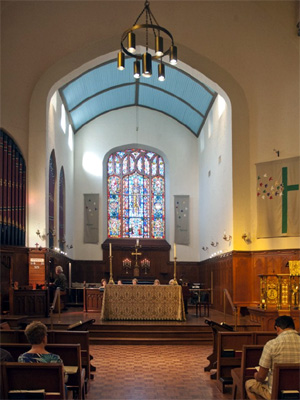| |
 |
 |
 |
| Comment on this report, or find other reports. |
 |
| Our Mystery Worshippers are volunteers who warm church pews for us around the world. If you'd like to become a Mystery Worshipper, start here. |
 |
| Find out how to reproduce this report in your church magazine or website. |
|
|
| 2852: St Paul’s, Sacramento, California, USA |
 |
 |
 |
Mystery Worshipper: Galadriel.
The church: St Paul’s, Sacramento, California, USA.
Denomination: The Episcopal Church, Diocese of Northern California.
The building: The present handsome stone building is the congregation’s third permanent home. The first church was replaced in 1870 after the city’s streets were raised to resist flooding by the Sacramento River. The second building was replaced at the beginning of the 20th century by the present structure, but not before its treasures were removed for use in the new building. These included three fine stained glass windows, one donated by Jane Stanford, co-founder of Stanford University, in memory of her only son, Leland Stanford Jr. Two of these windows survive; the third was lost to fire in 1915. This conflagration also destroyed the organ, which was subsequently replaced by an organ brought in from Williamstown, Massachusetts, and is claimed to be one of the oldest on the West Coast (although it is not in its original condition – see below).
The church: St Paul’s claims to be Sacramento’s first church; its earliest congregation met in a blacksmith’s shop in August 1849, with services conducted by the vicar of Trinity Church San Francisco. At various points in its history St Pauls’ has also been known as Grace Church and Christ Church Cathedral. The church describes itself as “a loving, accepting, diverse Christian community embracing all of God’s people through worship and service.” Its social outreach includes members gathering on the last Sunday of each month to pack more than 200 sack lunches for the needy. Daily services emphasise healing.
The neighborhood: Sacramento, in central California at the confluence of the Sacramento and American Rivers, is the state capital and the oldest incorporated city in California. It was named after the river, which in turn was named after the Most Blessed Sacrament by Spanish explorers who were awed by its breadth and power. The California state government forms the city's principal economic base. St Paul's Church is in downtown Sacramento, mostly surrounded by business premises, plus the Sacramento Memorial Auditorium across the street. It is not far from the original governor’s mansion, now an historic monument. There are comparatively few private homes in the immediate vicinity, but there are quite a few homeless people on the surrounding streets. Two attended the service and stayed for a free lunch (offered to all) afterward; another took advantage of a safe space to sleep on the parish hall verandah.
The cast: The celebrant was the Revd Helen Harper, associate, assisted by the Revd Deacon Rik Rasmussen. Unidentified members of the choir read the first and second lessons. The music was directed by Derek Sup, organist and choirmaster, who also composed the anthem sung during the offertory and played a waltz by Chopin on the church’s grand piano as a concluding voluntary after the service had ended.
The date & time: Sunday, April 19, 2015, 10.00am.
What was the name of the service?
Holy Eucharist.
How full was the building?
Not very full: 25–30 worshippers, including half a dozen in the choir.
Did anyone welcome you personally?
Yes, a personal welcome was offered by the church’s official welcomer, who greeted everyone cheerfully, handed over a service booklet, and invited all strangers to sign the church’s guest book.
Was your pew comfortable?
Yes, very. A padded seat, and ample space in the back of the seat in front for holding books.
How would you describe the pre-service
atmosphere?
Quiet. With so few people present, perhaps not surprising, but it did not feel unwelcoming.
What were the exact opening words of the
service?
"Good morning."
What books did the congregation use during the
service?
A service sheet for the day, and the Hymnal 1982.
What musical instruments were played?
Organ, piano, and during the offertory anthem a recorder. The organ is opus 503 of William A. Johnson & Son of Westfield, Massachusetts. It is a mechanical action organ but has been almost completely renovated from its original state.

Did anything distract you?
Yes – the "gentleman of the road" who arrived just before the sermon and sat behind me. He spent the rest of the service shuffling through his bags, unfolding and refolding papers fairly noisily, and also from time to time wandering about. I understand he may face challenging life issues, but such behavior is still distracting.
Was the worship stiff-upper-lip, happy clappy, or
what?
Solemn and dignified. A formal, well-organized Episcopal choral holy eucharist with healing. What more can I say? To describe it as a jolly romp would not be accurate! No bells, no incense, no chanting, but the celebrant was in eucharistic vestments and the choir in blue robes.
Exactly how long was the sermon?
12 minutes.
On a scale of 1-10, how good was the preacher?
8 – The Revd Helen Harper seemed very restrained, but her delivery was clear and her sincerity appeared to run deep.
In a nutshell, what was the sermon
about?
The sermon was founded on the day's gospel (Luke 24:36-48 – the risen Jesus reveals himself to his disciples as the Messiah) but also briefly alluded to the gospel for the previous Sunday (the story of Doubting Thomas). Both gospels deal with doubt and questions of proof. What proof do we have of the Resurrection if we were not there? Jesus' disciples struggled to believe and were on a steep learning curve, as they needed to be ready for Pentecost, when they would be required to model faith in action. So Jesus did something very simple: he ate with them, and since ghosts do not eat meals he could not have been a ghost. If we also believe, then we need fear nothing, and we too can share faith and fellowship – and food!
Which part of the service was like being in
heaven?
Being lightly hugged at the exchange of peace by one of the congregation’s more senior citizens. She went slowly round the church doing this to all. It was a kind and inclusive gesture.

And which part was like being in... er... the other place?
As already mentioned, distracting noisy fidgeting in the pew behind me. Also it was hard to juggle service sheet and hymn book and back, particularly during the latter part of the service where there was much brisk swapping between the two.
What happened when you hung around after the service looking lost?
No looking lost allowed! The service sheet invited all comers to “stay for coffee and become acquainted with us.” This message was reinforced by the official welcomer at the end of the service.
How would you describe the after-service
coffee?
Hot, acceptable quality, and a hot lunch was offered too, complete with birthday cake for everyone who had had a birthday in the last 16 months! At 11.30 this was on the early side for me, but appreciated. Everyone else seemed to be tucking in enthusiastically.
How would you feel about making this church your regular (where 10 = ecstatic, 0 = terminal)?
7 – I felt welcome enough but would prefer to worship with a larger congregation.
Did the service make you feel glad to be a
Christian?
Yes.
What one thing will you remember about all this in seven days' time?
That lovely lady who welcomed all with a hug. |
|
|
 |
 |
 |
| We rely on voluntary donations to stay online. If you're a regular visitor to Ship of Fools, please consider supporting us. |
 |
 |
 |
| The Mystery Pilgrim |
 |
| One of our most seasoned reporters makes the Camino pilgrimage to Santiago de Compostela in Spain. Read here. |
 |
 |
 |
| London churches |
 |
| Read reports from 70 London churches, visited by a small army of Mystery Worshippers on one single Sunday. Read here. |
| |
|
|
|
|


